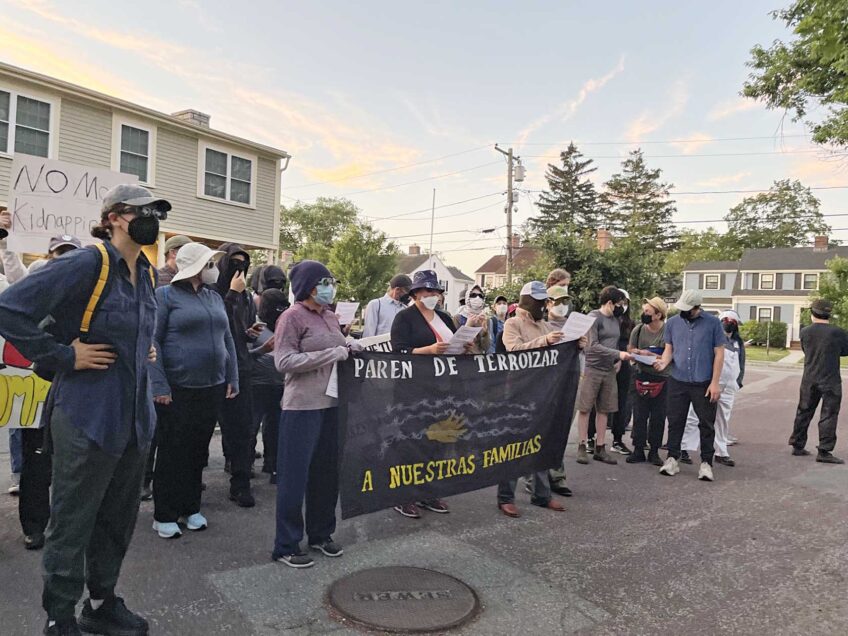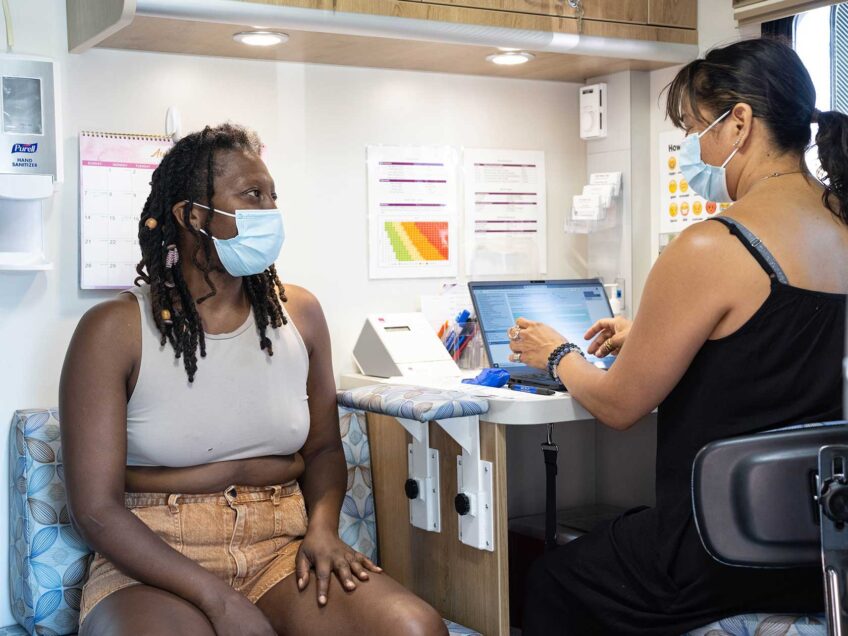Amid warming summers, a new initiative aims to make active transportation easier and cooler
In Revere, a mile-and-a-half stretch of the six-lane-wide Squire Road cuts past clusters of shops, a couple of grocery stores, and rows of residential streets.
Hidden behind those six lanes, a shopping center and some broad asphalt parking lots is the Rumney Marsh Reservation, and, beyond it, the ocean. But the roadway, with its dark surfaces and extensive pavement, traps heat and makes it hard for anyone outside of a car to traverse from one end to the other or to get to the natural resources on the other side, said Tom Skwierawski, the city’s chief of planning and community development.
Now, for walkers, bikers and those waiting for buses in Revere and other municipalities across the region, a new metro-area initiative aims to identify where urban heat most impacts such travelers — and what might be done about it.
The two-year project, called Neutralizing Onerous Heat Effects on Active Transportation, or NO-HEAT, last month received just over $1 million in a state grant, part of the state’s Municipal Vulnerability Preparedness Program that funds climate resilience efforts across Massachusetts.
With the funds, the Boston Region Metropolitan Planning Organization (MPO), the group spearheading the project, is aiming to collect new more specific data around heat impacts and active transportation — ways of moving like walking and biking —as well as later implementing some pilot cooling measures.
It will serve as a bridge between existing work the MPO has done around transit and around climate.
“This project helps us take that step forward, where we are bringing the two together. The goal of the project is to make it safer, more comfortable and easier for people to walk, bike and take transit,” said Rounaq Basu, manager of multimodal planning and design at the MPO and leader of the NO-HEAT effort.
Across the region, leaders see opportunities to make it easier to move through the spaces that are most impacted by heat.
“Our least walkable areas are also those that are most prone to heat risk,” Skwierawski said.
For workers who have to go outside in extreme heat, those temperatures can worsen existing health conditions like cardiovascular disease, diabetes, mental health, and asthma.
“When we talk about people’s exposure to extreme heat, it’s easy to say, ‘Stay inside’ when they can avoid something like a recreational activity — but for many of our community members and residents, they rely on public transportation, they rely on traveling on foot, on bike, via the bus network and subway networks. They have no other choice but to be exposed to heat to get to and from jobs that allow them to pay their rent,” said Ben Cares, director of the Department of Housing and Community Development in Chelsea, one of four municipalities partnering with the Boston Region MPO on the effort.
The other three municipal partners are Everett, Revere and Framingham. An MPO spokesperson said the municipalities were selected due to their density of environmental justice populations and a history of working to mitigate heat effects.
Extreme heat sometimes keep people from leaving their homes, even to find cooler spaces.
Marissa Zampino, a community organizer at the Mystic River Watershed Association, one of the nonprofits engaged in the NO-HEAT effort, said that she’s heard community members talk about avoiding leaving their houses in summer heat, even to go to places like cooling centers or pools, because of the temperatures in transit.
That’s an effect that comes from a lack of shade-providing tree canopy and green space as well as limited bus shelters, with many bus stops marked only by metal signs and no structure to provide shade. According to WBUR, as of early 2019, less than 10% of bus stops in the transit network had shelters and benches in place.
“The MBTA is never on time, so you get people waiting in front of a metal pole, with heat blaring up from the street, for 20 or 30 minutes on end,” Zampino said.
Building on existing work
Efforts to identify and address heat impacts are not new for the metro Boston area, as concerns grow around urban heat islands — those areas with limited green space and lots of dark, impermeable pavement that traps the heat of the sun during the day and holds it longer into the night.
The watershed association has done its own work around urban heat, work it is continuing alongside the MPO’s efforts. Through the city of Everett, its Wicked Cool Mystic project also received $687,000 in the latest round of Municipal Vulnerability Preparedness grant funding.
It’s not the only group to work on the problem. In Chelsea, the city has partnered with GreenRoots, a local environmental justice organization, as well as a team from Boston University, in an effort called Cool Block.
That project, centered around the Boys and Girls Club of Chelsea, looked to document extreme temperatures during the summer and try out some mitigation efforts like new trees, more green space and planters, and lighter-colored and more porous pavers that trap and hold less heat.
In Boston, a city plan released in April 2022 identified areas of vulnerability and high risk and introduced some citywide heat resilience strategies.
Addressing disparate impact
When it comes to urban heat, communities of color often bear the brunt of its impacts. Research from Columbia University found that historically redlined areas tend to experience significantly hotter summer temperatures.
That team found that, in Boston, areas that were historically redlined on average experienced temperatures up to about 105 degrees. In contrast, areas that had historically been rated more favorably by the Home Owners’ Loan Corporation — the organization that created the maps that drew red lines around certain neighborhoods that ultimately marked them for disinvestment — on average saw temperatures around 91 degrees.
And those same communities are often the ones who rely more frequently on modes of transportation other than cars. According to the National Equity Atlas, a project produced in part by a team at the University of Southern California, 18% of Black households and 10% of Latinx households didn’t have access to a car, compared to 6% of white households.
“People in vehicles have air conditioning. They can resolve [temperature issues] themselves,” said Brendan Kearney, executive director at WalkMassachusetts, one of the advocacy groups partnering on the effort. “For everyone else trying to get around, we need to find other ways for the community to help us out a little bit, to make sure that there’s a level of comfort there, too,”
In each of the four municipalities partnering in the NO-HEAT initiative, over 80% of census tracts in the communities are considered environmental justice populations, a designation that considers areas with high populations of color, low-income residents and community members for whom English is not a first language and may prove to be a barrier.
Fine-tuning data, building solutions
The first phase of the NO-HEAT project will focus on data collection around active transportation and urban heat. Basu said the team is aiming to put together heat data that will offer a more specific, microclimate perspective than most datasets out there. The datasets will, when completed, be released as open source information.
The second phase will attempt to pilot some solutions to make biking, walking, and waiting for public transit cooler.
The types of heat mitigation measures the NO-HEAT program will include have yet to be determined — Basu said that those solutions will be based on where impacts seem to be greatest and what those communities are looking for — but could include planting new greenery, installing more shade or using reflective paint that can bounce back heat from the sun, rather than having it get trapped in dark pavement surfaces like asphalt.
“We definitely want to engage the community, and we’re planning on doing walkability and bikeability audits as well as … getting the community to come along with us on those audits,” Basu said.
Zampino pointed to some solutions the Mystic River Watershed Association’s efforts have identified as examples of what cooling measures could look like, including adding shade at bus stops and planting trees — though expanding the tree canopy is not a short-term solution, as it can take years or decades to really start to generate good shade.
The group also found community interest in creating more access to water.
“Whether that’s a better pool, a new splash pad, a better splash pad or even water fountains, there’s definitely not enough publicly accessible water, just in the greater Boston area in general,” Zampino said.
And in Chelsea, with the Cool Block project, teams worked to install misting stations and plant new trees and planters that can cool the area through transpiration — when moisture from leaves evaporates, cooling both the plants and the area around them. It’s one of the effects that makes a tree-packed area cooler than nearby city streets.
With bus stations, Cares said efforts are not just about creating more shade, but installing more novel inclusions like misters and water fountains. The city also has been exploring painting roofs white, which can lower indoor temperatures. White and light-colored surfaces reflect sunlight and absorb less heat.
There were moves in the Cool Block project to include a white roof that ultimately didn’t pan out, but the city is now working with the Chelsea Housing Authority to include a white roof on one of their buildings, Cares said.
Basu said the NO-HEAT initiative also aims to identify recommendations for cooler routes community members could take while walking or biking, making temperature a way to pick directions, in the same way Google Maps helps prioritize preferred modes of transit or lowest-cost routes.
“Instead of taking what is usually the most popular or heavily walked route, we are going to look at alternatives that might be somewhat longer but provide those directions to people and saying, ‘Hey, this [route] is going to be this much cooler,” he said.
Bringing resilience across city lines
The NO-HEAT effort also marks a bigger push across city lines to jointly address climate change impacts.
Cares called the broad response, led by an MPO, an “excellent” move in addressing bigger challenges like urban heat.
“When we’re facing systemic problems like climate hazards and like extreme heat, it is imperative to have all of these partners together in the proverbial room,” he said
Kearney said this effort — combining work from a regional MPO with the Metropolitan Area Planning Council, advocacy groups and four municipalities — is bringing a bigger scale than he’s seen from many other projects.
The effort could serve as a model for how to bring together groups from across the spectrum to address an issue that has a broad, multisector impact.
“Climate is affecting transit. Climate is affecting housing,” Zampino said. “We really have to start making sure that climate organizations are connecting with the transit organizations and the housing organizations to work together with each other.”
The groups involved in the project said this effort is important in helping the four municipalities break out of silos that might normally exist and address an issue that goes beyond any one city or town.
“I think the biggest thing is just making sure that we’re all collaborating with each other, because that’s also an issue that we’re seeing, not just for heat, but climate in general,” Zampino said. “Climate change does not care about your municipal borders.”






